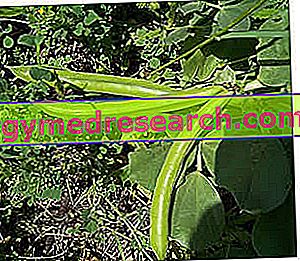Fave in history
It is said that - among the legumes - the beans are the least caloric in absolute; as for lentils and beans, even broad beans have acquired a leading role in ancient times as the food of the poor par excellence, given their low cost and simple availability.
The broad bean plant is native to Asia Minor and has been widely cultivated for human and animal food (forage) for centuries.

Botanical analysis
In botanical nomenclature, broad beans are known as Vicia faba L. or Faba vulgaris, and belong to the Fabaceae family : they are an annual herbaceous plant, capable of reaching 70-140 centimeters in height. The plant has an erect and thick stem, with a quadrangular section and much branched at the base; the root is tap-like and shows numerous ramifications. The growth of the broad bean plant is attributable to that of a giant green bean, with a fleshy and cylindrical pod.
Inside the pod, with an average length of about 20 cm, are the yellowish-brownish, flat, oval, large and fleshy seeds; the leaves, pinnate-compound and stipulate, are made up of small groups of 2-6 smaller leaflets.
Generality
There are numerous varieties of fava beans, mainly cataloged on the basis of the size of the seed: in fact, there are not only the vegetable beans (from the 25 cm pod with seeds as big as a crushed olive).
The favetta ( equina pers) is used above all for animal feeding: we are talking about a very particular variety of fava beans, in which a single pod can weigh 700-1, 000 grams.
The field bean (minor Beck) is a very impressive variety of beans: a pod can also contain 1, 000 seeds and weigh 700 grams. Like for favetta, favino beans are also used as fodder.
Food uses
The beans can be eaten cooked or raw, and are sold both dry and fresh.
After removing the integument that surrounds the beans, these can be dried, therefore preserved for longer times than the fresh ones. The dried private tegument beans do not require a preventive soaking time, typical of dried beans or lentils: they are in fact plunged into boiling water directly, or steamed. The end result is a sort of puree, excellent accompaniment for vegetables with a bitter aftertaste (eg chicory). Dried beans with the integument, unlike the previous ones, require a few hours of soaking before cooking.
Fresh broad beans can be eaten natural or used together with bread, salami or cheese.
Canned and frozen broad beans are sold on the market, clearly much more practical than dry ones.
Nutrient principles and properties
Compared to beans, the beans are qualitatively superior in terms of proteins (even if they are lower in quantity): these legumes contain, approximately, 5% protein, 5% fiber, 4.5% carbohydrate and very little fat ( 0.4%); the remaining 84% is water.
The beans are rich in iron, potassium, magnesium, copper, selenium and many vitamins, especially ascorbic acid: it is important to remember that with the cooking of beans, as indeed for all legumes, most of the vitamins and minerals are lost . Also the drying process alters the vitamin and mineral component. Due to the richness in iron, it seems that the consumption of broad beans is useful to counteract anemia.
The dried broad bean leaves are used in herbal medicine as a natural remedy to stimulate diuresis.
Pesto di Fave (Marò)
X Problems with video playback? Reload from YouTube Go to Video Page Go to Video Recipes Section Watch the video on youtubeBroad beans and related problems
- The beans are potential enemies of the immune system: in sensitive and predisposed subjects, the consumption of broad beans can trigger an allergic reaction which, in the most serious cases, can induce coma. In general, allergies are caused by the consumption of raw broad beans: in fact, cooking reduces their risk.
- Broad beans should not be consumed in conjunction with monoamine oxidase inhibitors (MAOIs): levodopa, contained in broad beans, is converted into dopamine in the body. The association of broad beans with dopamine - a vasoactive amine - can cause hypotensive crises of varying degrees, sometimes deadly.
- In sensitive and predisposed subjects, the consumption of broad beans (and of other particular substances, such as analgesic drugs, salicylates, some chemotherapeutic drugs, etc.), even if minimal, triggers a cascade of reactions in the body that inevitably lead to acute haemolysis with jaundice. Favism is a hereditary pathology in which the affected subject records the lack of the G6PD enzyme, implicated in the biogenetic pathway of pentose-phosphates.
Broad beans and levodopa
Especially in recent years, broad beans are increasingly in demand because apparently miraculous news has been divulged and promoted: beans are a source of levodopa, a drug of choice in the fight against Parkinson's disease.

However, there are no reliable studies or irrefutable demonstrations of the effect of levodopa contained in broad beans in the treatment of Parkinson's disease. However, the fact is that some patients suffering from this serious neurodegenerative disease have achieved good results following the frequent and regular consumption of beans. Other authors are confident and hopeful: they believe, in fact, that the seeds do not contain only levodopa, but also other substances capable of enhancing their effect.
What Science fails to understand is why only some patients respond positively to the "cure" with beans; for others, in fact, the effect is almost in vain. [information taken from the writings of Kathrynne Holden, dietitian]
However, in the case of Parkinson's disease, the doctor's opinion is always essential before embarking on a diet rich in beans.
Broad beans in brief »


